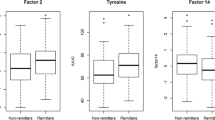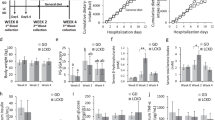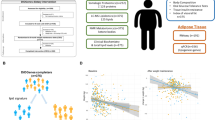Abstract
Objective:
We and others have previously characterized changes in circulating metabolite levels following diet-induced weight loss. Our aim was to investigate whether baseline metabolite levels and weight-loss-induced changes in these are predictive of or associated with changes in body mass index (BMI) and metabolic risk traits.
Methods:
Serum metabolites were analyzed with gas and liquid chromatography/mass spectrometry in 91 obese individuals at baseline and after participating in a 1 year non-surgical weight loss program.
Results
A total of 137 metabolites were identified and semi-quantified at baseline (BMI 42.7±5.8, mean±s.d.) and at follow-up (BMI 36.3±6.6). Weight-loss-induced modification was observed for levels of 57 metabolites in individuals with ⩾10% weight loss. Lower baseline levels of xylitol was predictive of a greater decrease in BMI (β=0.06, P<0.01) and ⩾10% weight loss (odds ratio (OR)=0.2, confidence interval (CI)=0.07–0.7, P=0.01). Decreases in levels of isoleucine, leucine, valine and tyrosine were associated with decrease in BMI (β>0.1, P<0.05) and ⩾10% weight loss (isoleucine: OR=0.08, CI=0.01–0.3, leucine: OR=0.1, CI=0.01–0.6, valine: OR=0.1, CI=0.02–0.5, tyrosine: OR=0.1, CI=0.03–0.6, P<0.02).
Conclusions:
Diet-induced weight loss leads to mainly reduced levels of metabolites that are elevated in obese insulin resistant individuals. We identified multiple new associations with metabolic risk factors and validated several previous findings related to weight loss-mediated metabolite changes. Levels of specific metabolites, such as xylitol, may be predictive of the response to non-surgical weight loss already at baseline.
This is a preview of subscription content, access via your institution
Access options
Subscribe to this journal
Receive 12 print issues and online access
$259.00 per year
only $21.58 per issue
Buy this article
- Purchase on Springer Link
- Instant access to full article PDF
Prices may be subject to local taxes which are calculated during checkout

Similar content being viewed by others
References
Moore SC, Matthews CE, Sampson JN, Stolzenberg-Solomon RZ, Zheng W, Cai Q et al. Human metabolic correlates of body mass index. Metabolomics 2014; 10: 259–269.
Newgard CB, An J, Bain JR, Muehlbauer MJ, Stevens RD, Lien LF et al. A branched-chain amino acid-related metabolic signature that differentiates obese and lean humans and contributes to insulin resistance. Cell Metab 2009; 9: 311–326.
Lien LF, Haqq AM, Arlotto M, Slentz CA, Muehlbauer MJ, McMahon RL et al. The STEDMAN project: biophysical, biochemical and metabolic effects of a behavioral weight loss intervention during weight loss, maintenance, and regain. Omics J Integrat Biol 2009; 13: 21–35.
Piccolo BD, Keim NL, Fiehn O, Adams SH, Van Loan MD, Newman JW . Habitual physical activity and plasma metabolomic patterns distinguish individuals with low vs. high weight loss during controlled energy restriction. J Nutr 2015; 145: 681–690.
Perez-Cornago A, Brennan L, Ibero-Baraibar I, Hermsdorff HH, O'Gorman A, Zulet MA et al. Metabolomics identifies changes in fatty acid and amino acid profiles in serum of overweight older adults following a weight loss intervention. J Physiol Biochem 2014; 70: 593–602.
Tochikubo O, Nakamura H, Jinzu H, Nagao K, Yoshida H, Kageyama N et al. Weight loss is associated with plasma free amino acid alterations in subjects with metabolic syndrome. Nutr Diabetes 2016; 6: e197.
Rauschert S, Uhl O, Koletzko B, Hellmuth C . Metabolomic biomarkers for obesity in humans: a short review. Ann Nutr Metab 2014; 64: 314–324.
Stroeve JH, Saccenti E, Bouwman J, Dane A, Strassburg K, Vervoort J et al. Weight loss predictability by plasma metabolic signatures in adults with obesity and morbid obesity of the DiOGenes study. Obesity 2016; 24: 379–388.
Ho JE, Larson MG, Ghorbani A, Cheng S, Chen MH, Keyes M et al. Metabolomic profiles of body mass index in the framingham heart study reveal distinct cardiometabolic phenotypes. PLoS One 2016; 11: e0148361.
Kaddurah-Daouk R, Kristal BS, Weinshilboum RM . Metabolomics: a global biochemical approach to drug response and disease. Annu Rev Pharmacol Toxicol 2008; 48: 653–683.
Cheng S, Rhee EP, Larson MG, Lewis GD, McCabe EL, Shen D et al. Metabolite profiling identifies pathways associated with metabolic risk in humans. Circulation 2012; 125: 2222–2231.
Zhou Y, Qiu L, Xiao Q, Wang Y, Meng X, Xu R et al. Obesity and diabetes related plasma amino acid alterations. Clin Biochem 2013; 46: 1447–1452.
Kim JY, Park JY, Kim OY, Ham BM, Kim HJ, Kwon DY et al. Metabolic profiling of plasma in overweight/obese and lean men using ultra performance liquid chromatography and Q-TOF mass spectrometry (UPLC-Q-TOF MS). J Proteome Res 2010; 9: 4368–4375.
Perng W, Gillman MW, Fleisch AF, Michalek RD, Watkins SM, Isganaitis E et al. Metabolomic profiles and childhood obesity. Obesity 2014; 22: 2570–2578.
Wurtz P, Soininen P, Kangas AJ, Ronnemaa T, Lehtimaki T, Kahonen M et al. Branched-chain and aromatic amino acids are predictors of insulin resistance in young adults. Diabetes Care 2013; 36: 648–655.
Wang TJ, Larson MG, Vasan RS, Cheng S, Rhee EP, McCabe E et al. Metabolite profiles and the risk of developing diabetes. Nat Med 2011; 17: 448–453.
Geidenstam N, Spegel P, Mulder H, Filipsson K, Ridderstrale M, Danielsson AP . Metabolite profile deviations in an oral glucose tolerance test-a comparison between lean and obese individuals. Obesity 2014; 22: 2388–2395.
Shah SH, Crosslin DR, Haynes CS, Nelson S, Turer CB, Stevens RD et al. Branched-chain amino acid levels are associated with improvement in insulin resistance with weight loss. Diabetologia 2012; 55: 321–330.
Geidenstam N, Magnusson M, Danielsson AP, Gerszten RE, Wang TJ, Reinius LE et al. Amino acid signatures to evaluate the beneficial effects of weight loss. Int J Endocrinol 2017; 2017: 12.
Geidenstam N, Danielsson AP, Spegel P, Ridderstrale M . Changes in glucose-elicited blood metabolite responses following weight loss and long term weight maintenance in obese individuals with impaired glucose tolerance. Diabetes Res Clin Pract 2016; 113: 187–197.
Johansson LE, Danielsson AP, Parikh H, Klintenberg M, Norstrom F, Groop L et al. Differential gene expression in adipose tissue from obese human subjects during weight loss and weight maintenance. Am J Clin Nutr 2012; 96: 196–207.
Alberti KGMM, Zimmet PZ, Consultation W . Definition, diagnosis and classification of diabetes mellitus and its complications part 1: Diagnosis and classification of diabetes mellitus - Provisional report of a WHO consultation. Diabetic Med 1998; 15: 539–553.
Matthews DR, Hosker JP, Rudenski AS, Naylor BA, Treacher DF, Turner RC . Homeostasis model assessment: insulin resistance and beta-cell function from fasting plasma glucose and insulin concentrations in man. Diabetologia 1985; 28: 412–419.
Spégel P, Danielsson AH, Bacos K, Nagorny CF, Moritz T, Mulder H et al. Metabolomic analysis of a human oral glucose tolerance test reveals fatty acids as reliable indicators of regulated metabolism. Metabolomics 2010; 6: 56–66.
Wuolikainen A, Jonsson P, Ahnlund M, Antti H, Marklund SL, Moritz T et al. Multi-platform mass spectrometry analysis of the CSF and plasma metabolomes of rigorously matched amyotrophic lateral sclerosis, Parkinson's disease and control subjects. Mol Biosyst 2016; 12: 1287–1298.
Chorell E, Moritz T, Branth S, Antti H, Svensson MB . Predictive metabolomics evaluation of nutrition-modulated metabolic stress responses in human blood serum during the early recovery phase of strenuous physical exercise. J Proteome Res 2009; 8: 2966–2977.
Leek JT, Johnson WE, Parker HS, Fertig EJ, Jaffe AE, Storey JD sva: Surrogate Variable Analysis. R package version 3140.
Team RC. R: a language and environment for statistical computing, 2015.
Benjamini Y, Hochberg Y . Controlling the false discovery rate - a practical and powerful approach to multiple testing. J Roy Stat Soc B Metab 1995; 57: 289–300.
Felig P, Marliss E, Cahill GF Jr . Plasma amino acid levels and insulin secretion in obesity. N Engl J Med 1969; 281: 811–816.
Yamakado M, Nagao K, Imaizumi A, Tani M, Toda A, Tanaka T et al. Plasma free amino acid profiles predict four-year risk of developing diabetes, metabolic syndrome, dyslipidemia, and hypertension in japanese population. Sci Rep 2015; 5: 11918.
Tripathy D, Almgren P, Tuomi T, Groop L . Contribution of insulin-stimulated glucose uptake and basal hepatic insulin sensitivity to surrogate measures of insulin sensitivity. Diabetes Care 2004; 27: 2204–2210.
Hassinger W, Sauer G, Cordes U, Krause U, Beyer J, Baessler KH . The effects of equal caloric amounts of xylitol, sucrose and starch on insulin requirements and blood glucose levels in insulin-dependent diabetics. Diabetologia 1981; 21: 37–40.
Islam MS, Indrajit M . Effects of xylitol on blood glucose, glucose tolerance, serum insulin and lipid profile in a type 2 diabetes model of rats. Ann Nutr Metab 2012; 61: 57–64.
Salminen S, Salminen E, Koivistoinen P, Bridges J, Marks V . Gut microflora interactions with xylitol in the mouse, rat and man. Food Chem Toxicol 1985; 23: 985–990.
Piccolo BD, Comerford KB, Karakas SE, Knotts TA, Fiehn O, Adams SH . Whey protein supplementation does not alter plasma branched-chained amino acid profiles but results in unique metabolomics patterns in obese women enrolled in an 8-week weight loss trial. J Nutr 2015; 145: 691–700.
Reinehr T, Wolters B, Knop C, Lass N, Hellmuth C, Harder U et al. Changes in the serum metabolite profile in obese children with weight loss. Eur J Nutr 2015; 54: 173–181.
Huffman KM, Shah SH, Stevens RD, Bain JR, Muehlbauer M, Slentz CA et al. Relationships between circulating metabolic intermediates and insulin action in overweight to obese, inactive men and women. Diabetes Care 2009; 32: 1678–1683.
Wurtz P, Makinen VP, Soininen P, Kangas AJ, Tukiainen T, Kettunen J et al. Metabolic signatures of insulin resistance in 7,098 young adults. Diabetes 2012; 61: 1372–1380.
Ferrannini E, Natali A, Camastra S, Nannipieri M, Mari A, Adam KP et al. Early metabolic markers of the development of dysglycemia and type 2 diabetes and their physiological significance. Diabetes 2013; 62: 1730–1737.
Gall WE, Beebe K, Lawton KA, Adam KP, Mitchell MW, Nakhle PJ et al. alpha-hydroxybutyrate is an early biomarker of insulin resistance and glucose intolerance in a nondiabetic population. PLoS One 2010; 5: e10883.
Cahill GF Jr . Fuel metabolism in starvation. Annu Rev Nutr 2006; 26: 1–22.
Acknowledgements
We are greatly indebted to the study subjects for their participation. This study was supported by the Swedish Research Council, the Diabetes Association in Malmö, Region Skåne, ALF, Novo Nordisk-, Crafoord-, Skåne University Hospital-, Albert Påhlsson-, Lundberg-, Magnus Bergvall-, Fredrik and Ingrid Thurings-, Borgströms-, and Lars Hierta Foundations.
Author information
Authors and Affiliations
Corresponding author
Ethics declarations
Competing interests
The authors declare no conflict of interest.
Additional information
Supplementary Information accompanies this paper on International Journal of Obesity website
Supplementary information
Rights and permissions
About this article
Cite this article
Geidenstam, N., Al-Majdoub, M., Ekman, M. et al. Metabolite profiling of obese individuals before and after a one year weight loss program. Int J Obes 41, 1369–1378 (2017). https://doi.org/10.1038/ijo.2017.124
Received:
Revised:
Accepted:
Published:
Issue Date:
DOI: https://doi.org/10.1038/ijo.2017.124
This article is cited by
-
Profile of gut microbiota and serum metabolites associated with metabolic syndrome in a remote island most afflicted by obesity in Japan
Scientific Reports (2022)
-
Metabotyping for Precision Nutrition and Weight Management: Hype or Hope?
Current Nutrition Reports (2022)
-
Plasma metabolites associated with homeostatic model assessment of insulin resistance: metabolite-model design and external validation
Scientific Reports (2019)
-
Are we close to defining a metabolomic signature of human obesity? A systematic review of metabolomics studies
Metabolomics (2019)



